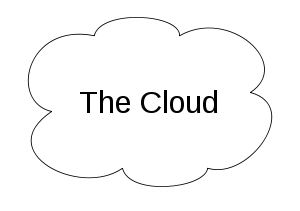
- Image via Wikipedia
Before companies can migrate their IT to “private” or “public” clouds, they need a better grasp of current costs.
Unless you’ve been on a very long sabbatical, you have no doubt heard about “cloud computing” as the future of information technology. But the conversation is quickly morphing from a discussion of “the cloud” to a potentially confusing choice between “public clouds” and “private clouds.”
Definitions of cloud computing vary, but, until recently, most centered around the concept of moving computing functionality from behind corporate firewalls onto the Internet. A computing task moved to the cloud becomes a service provided by a third party in its own data center, allowing companies to scale down their huge investments in IT hardware, software, and staff.
So the advent of the term “private cloud” may strike you as an oxymoron, because it keeps much of the IT action behind a company’s firewall — and much of the expense on its books.
But many companies, particularly large ones, are moving more avidly toward private clouds than toward public ones. (Gartner forecasts that, through 2012, the top 1,000 global corporations will spend more on building private clouds than on buying public-cloud services.) Some, in fact, may be moving that way without even realizing it.
That’s because computing clouds depend largely on the virtualization of computer servers, which are configured to serve multiple applications, and on sophisticated automation that shifts work among the servers as efficiently as possible. Companies have been adopting greater virtualization for several years. How many of them would regard this effort as building a “private cloud” is an open question.
See full article at: Your Cloud or Mine? – – CFO.com.
Related articles by Zemanta
- Managing through the ‘scariest’ part of private cloud evolution (zdnet.com)
- Hedge your bets in cloud computing (news.cnet.com)
- AppFirst Selected by CloudSigma as Cloud Monitoring Solution (eon.businesswire.com)
- Developers Chose Google, IBM as the Top Cloud Vendors (taragana.com)
- Companies can’t handle the cloud computing truth; You’re not ready (zdnet.com)
- Seattle’s Growing Advantage in The Cloud (xconomy.com)
- How to build a career in cloud computing (itworld.com)
- Thinking of moving to the cloud? Send in the lawyers first (infoworld.com)
- Overcoming Fear Of The Cloud (forbes.com)












